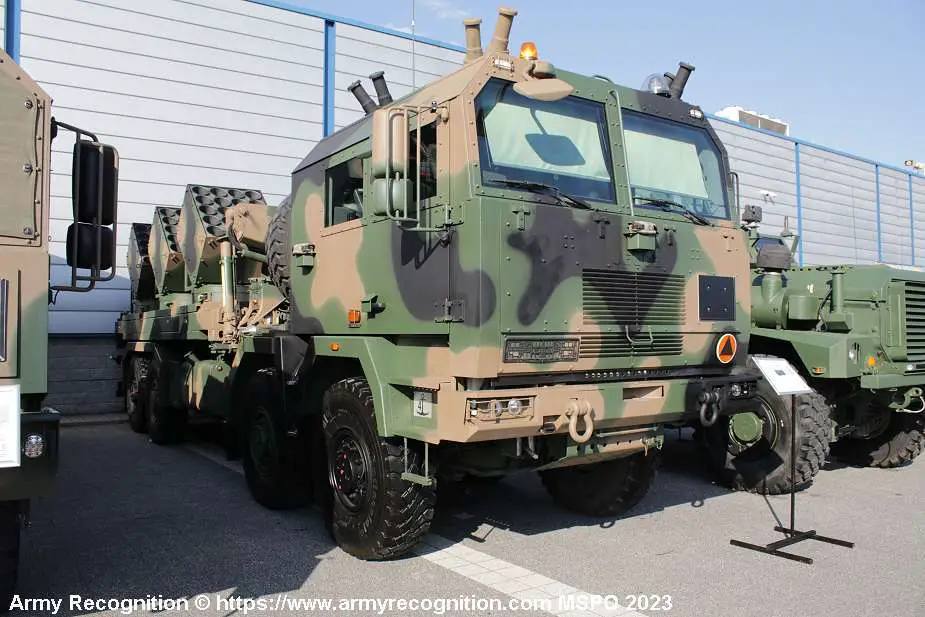Breaking news
MSPO 2023: Polish HSW Baobab-K breaks cover as the future of automated mine-laying system.
The 2023 edition of the MSPO International Defence Industry Exhibition features the unveiling of the Baobab-K, a truck-mounted scatterable mine-laying system. Developed through a collaboration between Polish companies Huta Stalowa Wola (HSW) S.A., Jelcz, Belma, WB Group, and the Military Institute of Engineering Technology, the system aims to offer a range of options for the automatic deployment of barrier minefields.
Follow Army Recognition on Google News at this link

Baobab-K features six mine-launching units, each engineered by Belma, mounted on rotating platforms at the rear of the truck (Picture source: Army Recognition )
Originating from the Baobab prototype introduced in September 2013, the Baobab-K was developed after HSW and its partners secured a contract from the Polish military's procurement division in December 2018. This collaborative project brings together the specialized skills of each company to produce a reliable and technologically sophisticated mine-laying system.
Built on the Jelcz P662D.43 8x8 truck chassis, known for its robustness and maneuverability, the Baobab-K is designed for operations in a variety of terrains. The chassis, which can also support American HIMARS or South Korean Chunmoo K239 rocket launchers, measures roughly 11 meters long, 2.6 meters wide, and 3.4 meters high, including the launcher units. With a combat weight of 31,700 kg, a top road speed of 85 km/h, and an off-road range of around 580 km, the system is well-suited for diverse operational conditions.
The Baobab-K features six mine-launching units, each engineered by Belma, mounted on rotating platforms at the rear of the truck. These units can hold up to twenty preloaded magazines produced by WB Group, with each magazine capable of carrying five anti-tank mines. This results in a total capacity of 100 mines per unit. The system is compatible with two kinds of anti-tank mines: the MN123.1 for immediate action and the MN123.2 for delayed action, offering operational flexibility.
The MN-123 anti-tank mines are designed to effectively penetrate armored vehicles and are equipped with Misznay-Schardin shaped charges on both sides. These mines can penetrate up to 60 mm of armor at an offset of 0.3 meters and are activated by the movement of vehicles over them. They feature an electronic magnetic influence fuze powered by a 6.8 V battery and include three separate safety mechanisms to reduce the risk of unintended detonation. Additionally, they come with programmable self-destruct options for automatic deactivation after a set period.
Controlled by a ground station developed by the Military Institute of Engineering Technology, the Baobab-K offers automated mine-laying capabilities. The control unit can be set to either manual or automatic mode for customizing minefield parameters. In automatic mode, the onboard computer, integrated with WB Group technology, calculates various factors such as vehicle speed, launcher settings, and mine deployment frequency. These parameters can be logged, displayed on digital maps, and shared via advanced communication systems for better coordination with higher command units.
The Baobab-K's deployment features allow for the precise and efficient creation of minefields. Mines can be launched from various positions relative to the vehicle, including the center line, sides, and rear. The system's launch settings enable mine deployment at distances between 30 and 90 meters and at speeds ranging from 5 to 25 km/h. This allows for the creation of extensive minefields up to 1,800 meters long in less than 22 minutes. The reloading process, aided by the launcher units developed by Belma, can be completed in under 30 minutes, allowing for quick re-engagement if necessary.






















